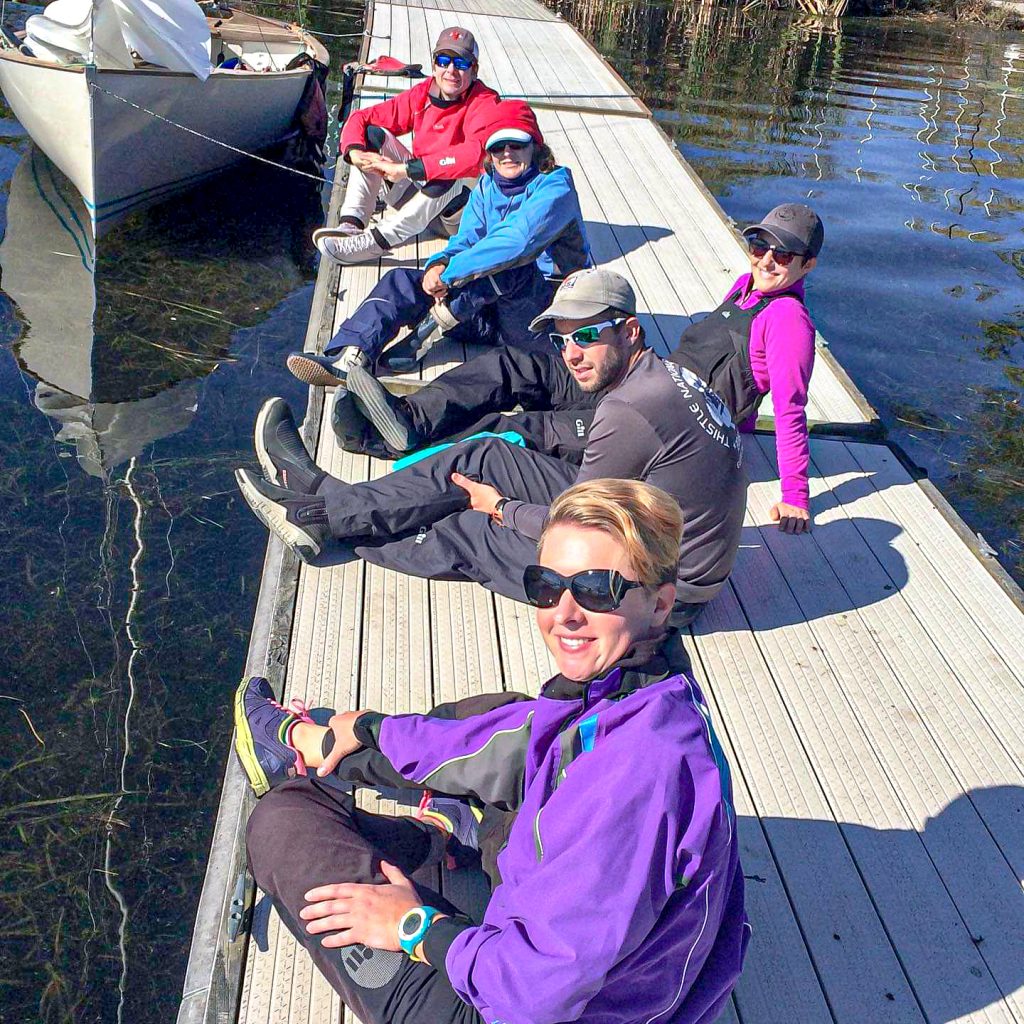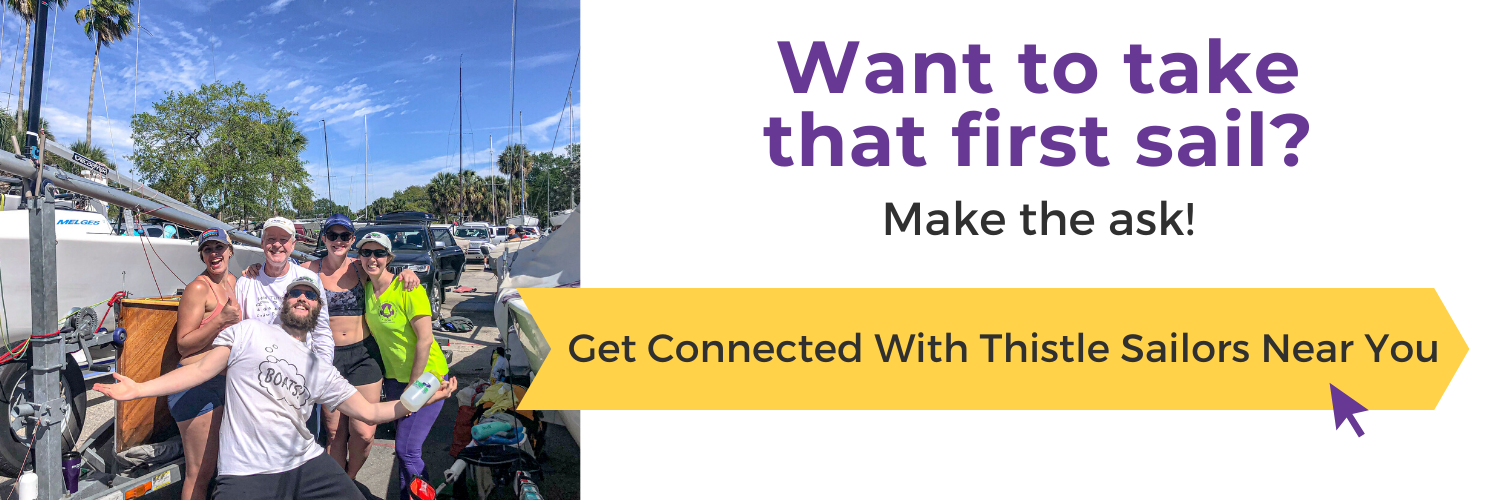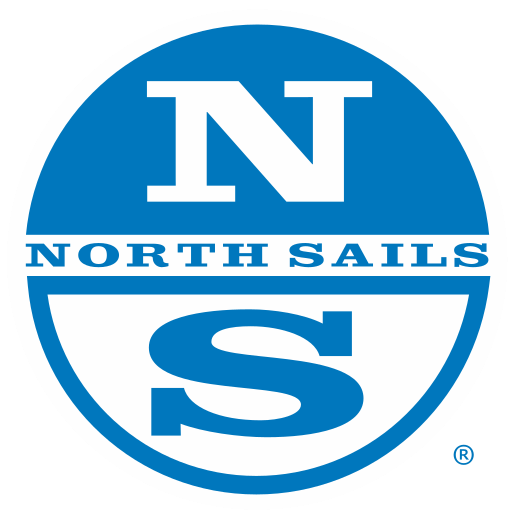What to Expect
Get prepared for your first time on a Thistle
Don’t be stuck on shore… give it a shot!
Love being active outside? Try sailing a Thistle with us. You’ll enjoy being in the boat – it’s fun and fast – and you’ll be welcomed by a great community of people.
Tackling something new can be intimidating. Here’s how to prepare and what you can expect the first time you sail on a Thistle.
Looking for someone to take you on your first Thistle ride? Find a fleet near you and don’t be afraid to ask!
How to prepare for your first Thistling experience
Get excited! The best way to have a good experience on a Thistle is to prep the right way.
What to wear
This will depend on the weather, but here are some guidelines of what works best. Whatever you’re wearing should be (relatively) comfortable when wet. That means no cotton! And remember: dress in layers. You can always take a layer off when you’re on the water, but it can be hard to add one. No need to be uncomfortable!
The basics:
- Life jacket if you have one (no worries if you don’t – someone will lend you one)
- Old sneakers that can get wet (or close-toed water shoes)
- Wicking fabrics (i.e. workout clothes)
- Layers
- Layers
- Layers* (sense a theme here?)
- Sunglasses (someone might add an electrical tape strap to them)
- Sunscreen (even when it’s cloudy)
- Water bottle (plastic or metal)
- Boat snacks (ex. energy bar, apple, sandwich in a resealable bag)
- Bag with dry clothes, footwear and a towel for afterward (casual, not #yachtclub fashion)
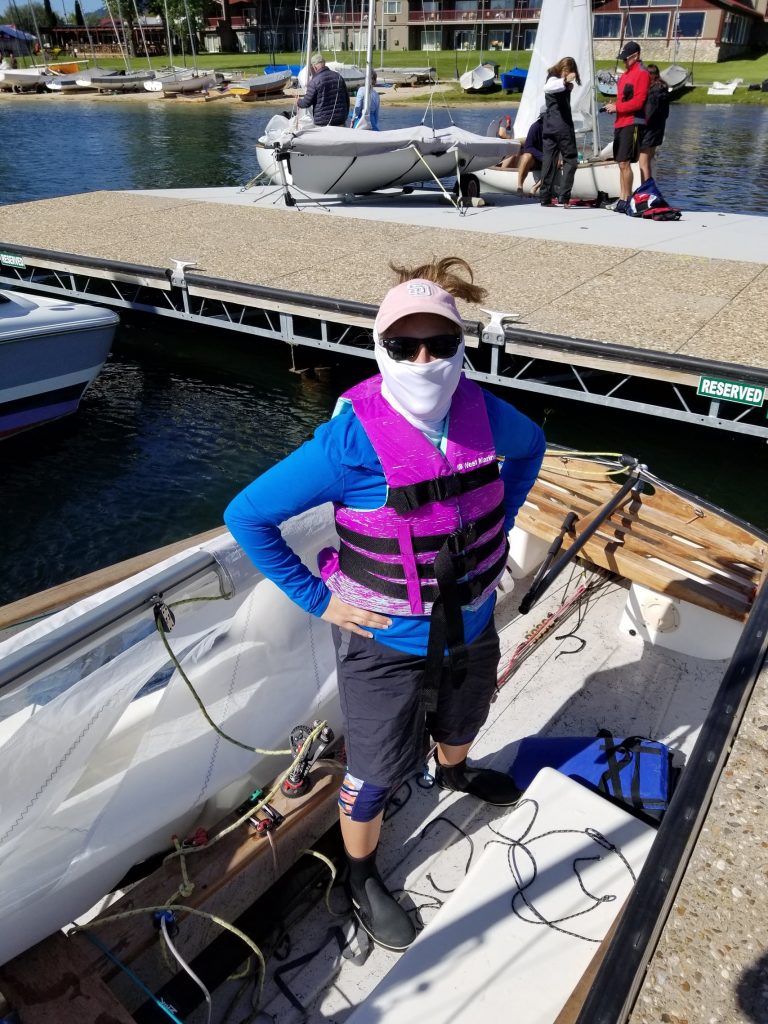
The extras:
When it’s hot out | When it’s cool out |
Ball cap or sun hat | Wool or fleece beanie |
Neck gaiter/buff | Fleece neck warmer |
Wicking socks | Wool socks (think skiing or winter hiking) |
*UPF sun hoodie | *Fleece vest, fleece jacket, wool layer |
Lip balm with SPF | *Warm/fleece leggings |
Another water bottle (or two) | Waterproof or water-resistant rain coat |
Prep Questions
The person you’re meeting might not think to give you all the necessary details. Here’s a list of things to ask before you show up:
- What time should I get there so I have enough time to get familiar with the boat while it’s on shore?
- How do I get there? Will my phone’s map work, or do I need better directions?
- Where should I park?
- Will I need to check in anywhere?
- How will I know where to find you?
- Do you have a life jacket I can borrow in the right size?
- What do you recommend wearing based on the forecast?
- Do I need to bring food for the boat or after sailing?
- Is there anything special I should bring?
- Is this a regatta, a fleet race, or are we just practicing? You know I’ve never done this before, right?*
You might feel funny playing 20-questions, but having this information beforehand will make the day go easier.
*While competing in a regatta isn’t always the easiest first experience, the right team can keep the mood calm. If you’re nervous about it, ask if you can go for a sail a week or two before the event.
Sailing Lingo
It might seem like another language, so here are some terms to learn. Don’t worry about having them memorized.
Roles
- Skipper – the person who drives the boat and manages the main sail
- Middle crew – the person who sits between the skipper and the forward; they manage the jib and the spinnaker
- Forward crew – the person who sits closest to the bow; they manage the spinnaker pole and several smaller lines that control different parts of the boat
Orientation
- Starboard – right side of the boat when you’re looking forward
- Port – left side of the boat when you’re looking forward (memory hack: port and left both have four letters)
- Bow – the front end of the boat
- Stern – the back end of the boat
Parts
- Main – the big, white sail; it’s connected to the mast and the boom
- Jib – the small, white sail at the front
- Spinnaker – the third sail, often colorful. AKA chute, spin, kite
- Line – when a rope is on a boat, you call it a line
- Sheet – a line (rope) that controls a sail
- Boom – the horizontal metal pole that moves from one side of the boat to the other. This can hit your head if you’re not careful; when someone says duck, duck
- Mast – the vertical metal pole that holds up the sails
- Spinnaker pole – 6’ metal pole that, when in use, connects to the mast on one end and the spinnaker sheet (rope that controls the spinnaker) on the other. AKA spin pole
Actions
- Tack – the boat is going to turn (through the wind), and the boom will cross to the other side. Duck. You’ll usually switch sides of the boat when this happens
- Jibe – like a tack, but the boat turns away from the wind. DUCK
- Hike – when you sit on the rail (the narrow wooden piece on each side of the boat) and lean out a bit; use the hiking strap to help
- Trim/sheet – pull in, as in “trim that line” (pull in that rope)
- Ease – loosen a line, as in “ease the jib sheet” (loosen the rope that’s attached to the jib)
- Heeling – when the boat tips to one side (you’ll probably hike to keep it flat)
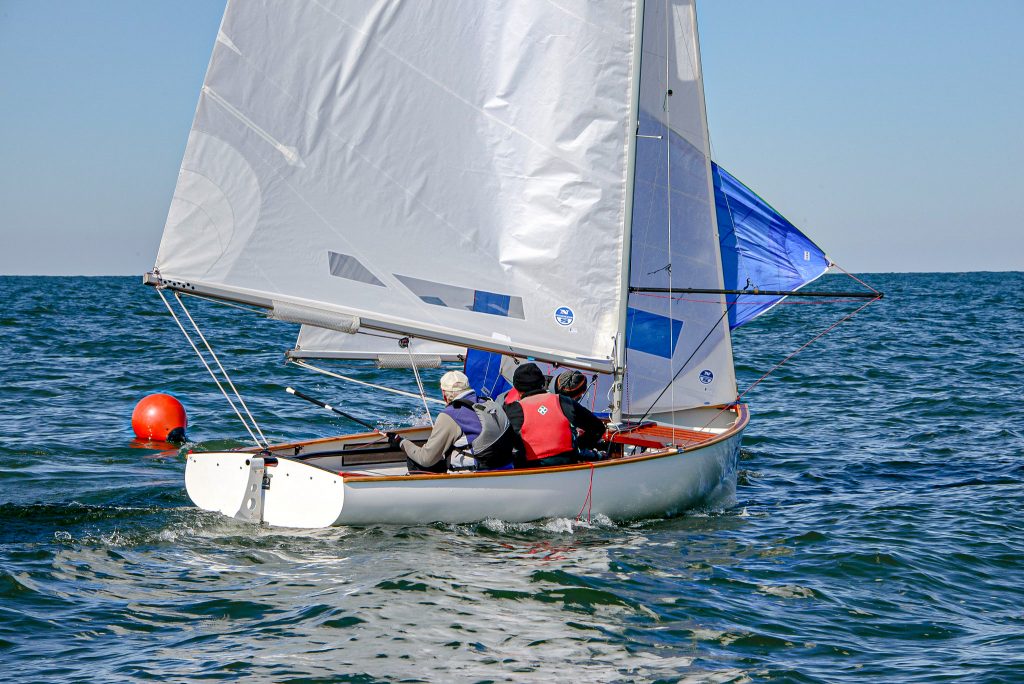

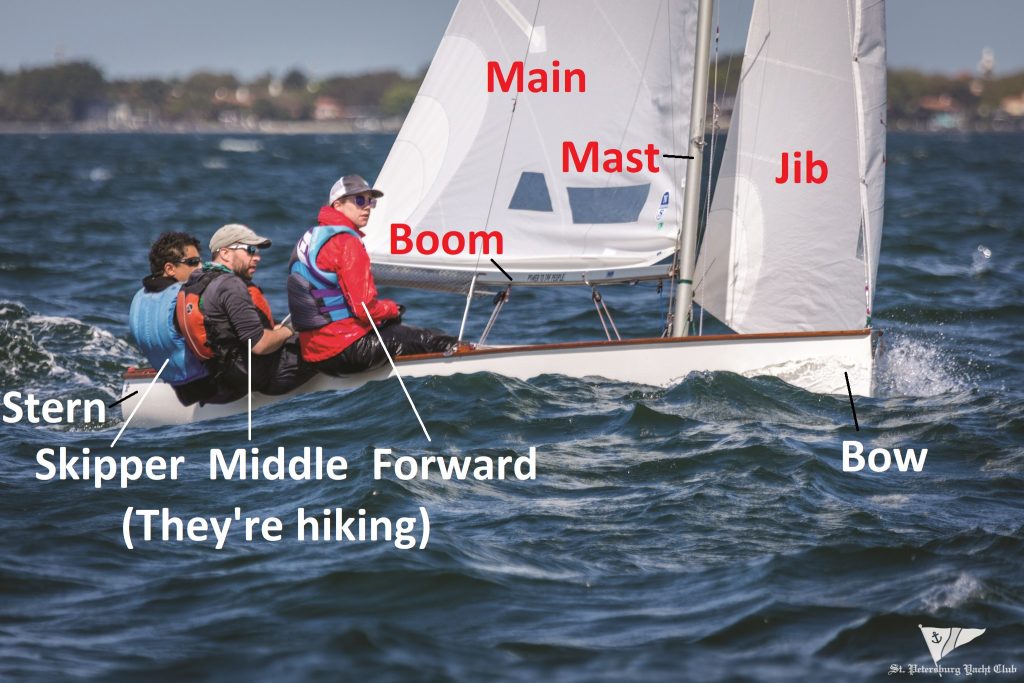
Get a sneak peek of what you’ll do on the boat
Watch a couple minutes of the Thistle Crew University video. The quality isn’t great, but you’ll find the content helpful.
Hiking – 11:15
Managing the jib – 14:58
Tacking – 16:52
Setting the spinnaker pole – 32:30
Managing the spinnaker – 36:35
Jibing – 44:48
What to Expect Once You're There
You made it to the boat! Now the fun begins. It’s okay to feel nervous, but remember to enjoy it. 1. You’re outside. 2. You’re about to try sailing (in a beautiful boat). 3. You’re with a fun group of people. Life is good.
Meeting Your Team
When you meet your team, you’ll find out who’s doing what role. You’ll either be the middle or forward crew. From there, here’s how to get comfortable with the boat.
Ask your skipper or the other crew to:
- Walk you through the main parts you’ll be managing (see list above).
- Tell you where on the boat you can put your water and snacks.
- Show you where to put your feet for a tack and what lines you need to manage or avoid.
- Demonstrate how to hike and then let you practice using the hiking strap.
- Explain your upwind responsibilities. If you’re the middle crew, this will include managing the jib.
- Explain your downwind responsibilities. These might include managing the spinnaker pole or managing the spinnaker itself (known as “flying” the spinnaker).

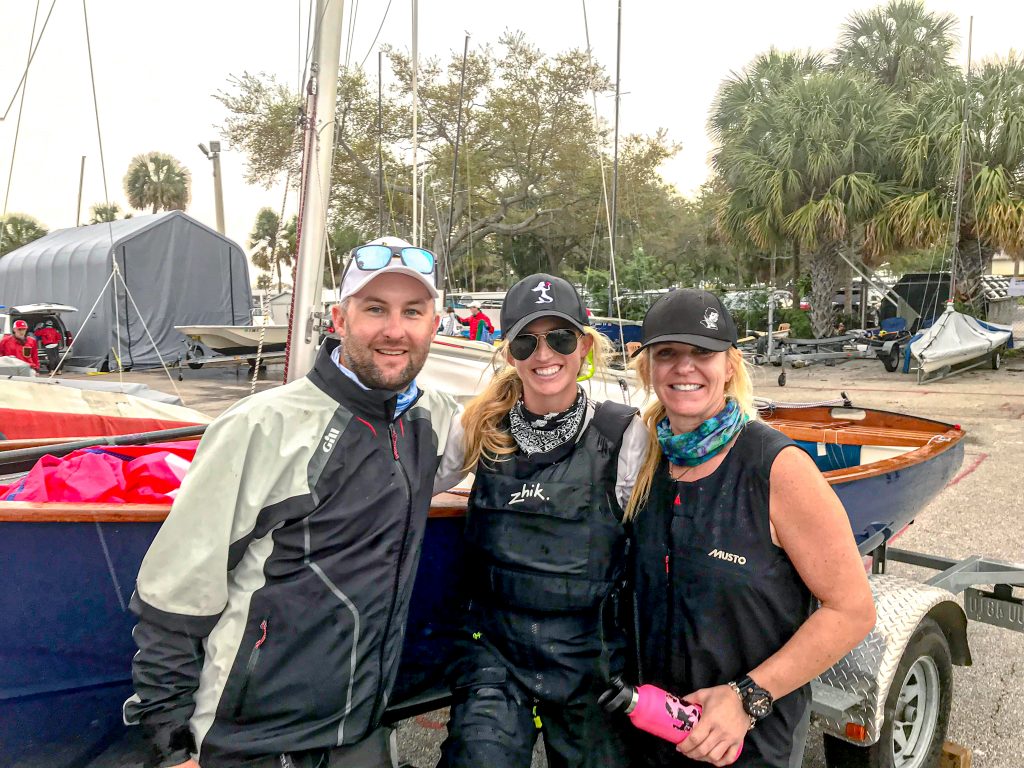
Going Sailing
It’s time! Stash your water and snacks in the boat. Put on one more clothing layer than you think you need. Check that life jacket.
Things to remember:
- Your weight placement makes a difference because of how responsive Thistles are.
- Be aware of where you’re sitting and stepping. There are lots of moving parts on a sailboat!
- When the skipper says you’re about to tack or jibe, duck lower than you think is necessary.
- Enjoy it! Take time to notice how the boat moves through the water and how the breeze affects your speed.
Stay Positive
Anytime you try something new you’re bound to feel a bit uncomfortable. Here are some important things to remember.
This might be hard at first, and you’ll feel like you’ll never catch up.
Moving your body around the boat without falling over. Knowing what those strange words mean. Deciphering directions and trying (again and again) to do the job. This isn’t easy! Be patient with yourself, and know that your crew members don’t expect you to get the hang of it right away.
Remember: a lot of these people have been sailing Thistles for years. When they make it look easy, don’t get discouraged. You’ll get there if you keep coming back.
Thistling can feel scary or dangerous.
The first time the boat tips, you might find yourself holding your breath. Thistles are tippy, and it’s not a sensation most people are used to experiencing. It might be windier than you had hoped. The waves might seem really big. Breathe.
There are definitely times when Thistle sailing will pump up your adrenaline, and there is some risk to this sport, but we’re smart about safety. And that life jacket? Wear it.
Coming Back for a Second Sail
You did it! Even if you’re not sure this is the sport for you, come back to try once more. Nothing is as intimidating the second time. Here are some tips for your next sail:
Did you have fun? Ask your skipper when you can come back. Get phone numbers, and don’t be afraid to use them. Even if the boat you were on can’t take you for your next sail, someone else will. Ask if there’s a group chat or email list you could join. Some groups use those to set up who’s sailing with whom next time. There might be a regular schedule of sailing with an open invitation to show up and get on a boat.
Was it too intense? Ask someone if there’s a more laid-back person you can sail with. It’s okay. Not everyone meshes well as a team. Were you racing? Ask if there are any events or practices that would be more low-key. Just like most new experiences, it takes a few times to get comfortable in the boat. Make sure you exchange phone numbers with the people you’ve met, and tell them you’d like to try again sometime!


